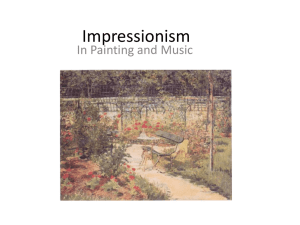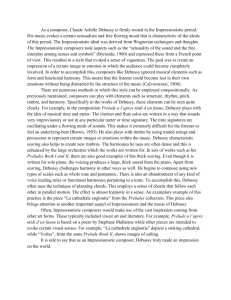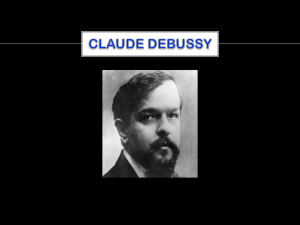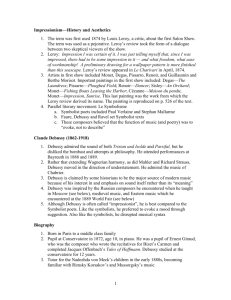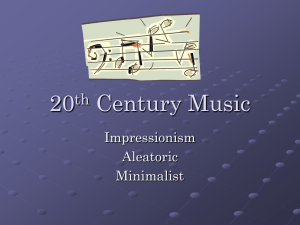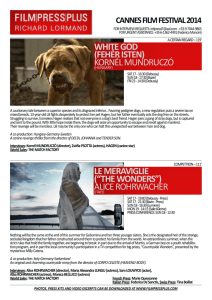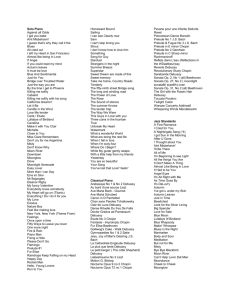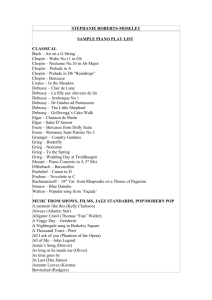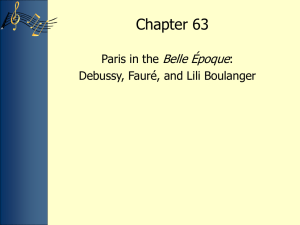Impressionism in Debussy's Piano Music: The Preludes Figure 1
advertisement
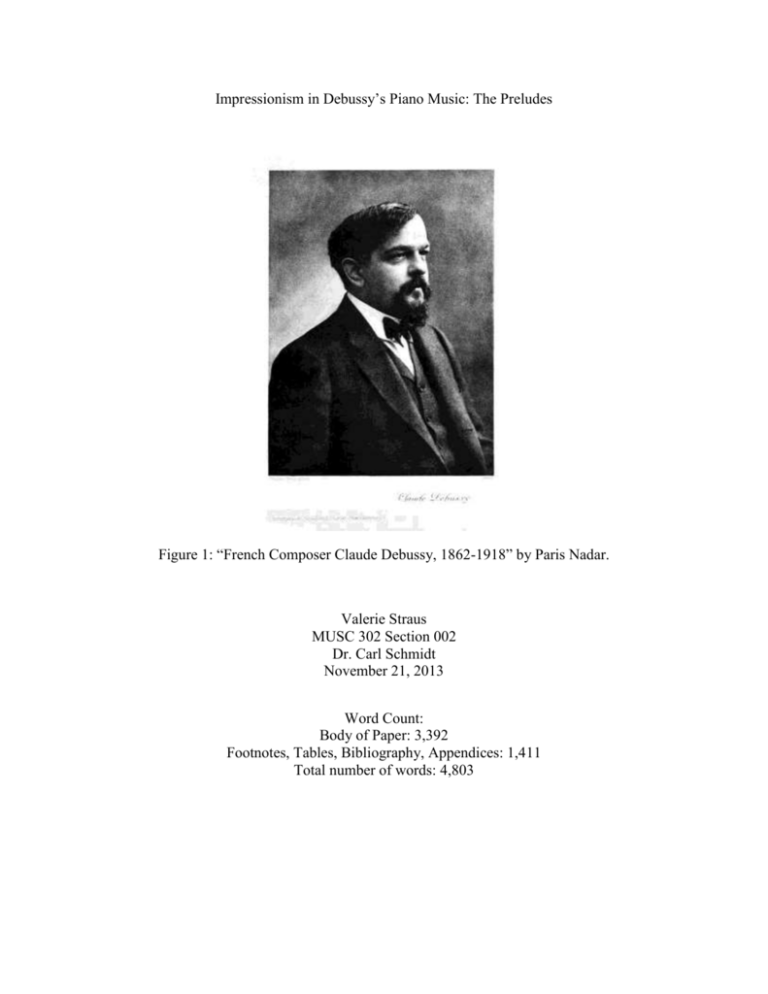
Impressionism in Debussy’s Piano Music: The Preludes Figure 1: “French Composer Claude Debussy, 1862-1918” by Paris Nadar. Valerie Straus MUSC 302 Section 002 Dr. Carl Schmidt November 21, 2013 Word Count: Body of Paper: 3,392 Footnotes, Tables, Bibliography, Appendices: 1,411 Total number of words: 4,803 Claude Debussy was renowned for his artistic compositions and inspiring piano works. His piano music illustrates his inspiration from Impressionist artwork, literature, family, and nature, transcribing these influences in his music through the exploration of new compositional styles and approaches to piano playing. Debussy’s twenty-four Preludes portray highly contrasting subjects based on Impressionistic influences through the use of newly discovered nontraditional scales, chords, and other musical styles to delineate these influences through his compositions. Biography Debussy (August 22, 1862 – March 25, 1918), born in Saint-Germain-en-Laye, France, entered the Paris Conservatoire at age eleven where he studied solfège with Albert Lavignac, piano with Antoine Marmontel, harmony with Émile Durand, and accompaniment with August Bazille.1 Primarily a pianist, he accompanied the Société Concordia and performed with the Société Nationale.2 He won the Prix de Rome with L’Enfant prodigue in 1884 and was a music critic from 1901 to 1914. Debussy’s first public solo piano performance was not until age fifty, when he performed some of his Preludes between 1911 and 1913.3 Debussy composed over eighty piano pieces, several of which were influenced by his daughter Claude-Emma, or ChouChou, who died prematurely. François Lesure and Roy Howat, “Debussy, Claude,” Grove Music Online, accessed October 5, 2013, Oxford Music Online. 1 2 Oscar Thompson, Debussy, Man and Artist (New York: Tudor Publishing Company, 1940), 250. 3 Roy Howat, The Art of French Piano Music: Debussy, Ravel, Fauré, Chabrier (New Haven: Yale University Press, 2009), 18. 1 Impressionism Debussy claimed to appreciate art almost as much as music,4 resembling Impressionist painters and Symbolist poets in his compositions.5 The term “Impressionism” derived from Monet’s painting “Impression: Sunrise” (1872),6 originally used in a derogatory sense. Expert Paul Roberts discusses Impressionists, noting that they were: “. . . a culmination of the Realist movement that stressed ‘truth’ and ‘sincerity’ in art, and whose themes were the often mundane facts of modern life.”7 Impressionist music is composed using “. . . veiled, iridescent lines, disintegration of sounds, predominance of color in the orchestration. . . .”8 French art historian and novelist Romain Rolland said of Debussy, “Like the impressionist painters of his time he paints in pure colors, though with a delicate sobriety. . . .”9 The key to Impressionism in painting was new awareness of color relationships and juxtaposing light and color, which Debussy aimed to reflect in his compositions. Piano Works: Techniques and Style Debussy explored the use of nontraditional scales and familiar tonal material in unfamiliar successions,10 favoring ostinato used to portray natural phenomena, such as wind, Mark McFarland, “Debussy: The Origins of a Method,” Journal of Music Theory 48, no. 2 (2004): 298, accessed September 29, 2013, RILM Abstracts of Music Literature. 4 5 Oscar Thompson, Debussy, Man and Artist (New York: Tudor Publishing Company, 1940), 21. François Lesure and Roy Howat, “Debussy, Claude,” Grove Music Online, accessed October 5, 2013, Oxford Music Online. 6 7 Paul Roberts, Images: The Piano Music of Claude Debussy (Portland: Amadeus Press, 1996), 116. 8 Lesure and Howat, “Debussy, Claude,” Grove Music Online. 9 Thompson, Debussy, Man and Artist, 19. David Kopp, “Pentatonic Organization in Two Piano Pieces of Debussy,” Journal of Music Theory 41, no. 2 (Autumn 1997): 261, accessed September 30, 2013, JSTOR. 10 2 leaves, mist, or water. In his earlier studies, he focused on pitch organization, using common alternative scales, such as whole tone, octatonic, and pentatonic. His earlier compositions shied modulation, reserving key changes for new sections or episodes. Early works include Deux Arabesques, Mazurka, Rêverie featuring unusual harmonies, and Valse romantique with strange harmonies using sevenths and ninth chords.11 Debussy’s early phase (1888-1890) consisted of small conventional style pieces, but a Ravel performance in 1898 may have influenced his change to a new style.12 He wrote of the “need to transcend the strictures of form and the limits of conventional harmonic progression in order to create music based more directly on color and beauty of sound.”13 Erik Satie encouraged him to write untraditionally with inspiration from artists like Monet, Renoir, and Pissaro,14 exploring tritone and fifth relationships, nonfunctional parallel harmonies, harmonics, and dissonances. Debussy’s later pieces utilized direct key relationships contrasting between ditonality and chromaticism with frequent modulation.15 His Pour le piano (1896-1901), first memorably performed in 1902,16 includes “Prélude” using augmented triads and a whole-tone scale, “Sarabande” with daring sevenths and ninths in a sincere melody, and “Toccata” with 11 Alfred Cortot, French Piano Music, trans. Hilda Andrews (New York: Da Capo Press, 1977), 3. 12 Paul Roberts, Images: The Piano Music of Claude Debussy (Portland: Amadeus Press, 1996), 7. David Kopp, “Pentatonic Organization in Two Piano Pieces of Debussy,” Journal of Music Theory 41, no. 2 (Autumn 1997): 261, accessed September 30, 2013, JSTOR. 13 Haymarket, “Claude Debussy (1862-1918): The Gramophone Guide to the Best Debussy Recordings,” Gramophone: The world’s authority on classical music since 1923, Last modified June 12, 2013, http://www.gramophone.co.uk/features/focus/claude-debussy-1862-1918. 14 15 Roy Howat, The Art of French Piano Music: Debussy, Ravel, Fauré, Chabrier (New Haven: Yale University Press, 2009), 8. 16 Roberts, Images, 5. 3 decorative arpeggios and interesting rhythm.17 Estampes (1903) includes “Pagodes,” “Soirée dans Grenade,” and “Jardins sous la pluie” dedicated to painter Jacques-Émile Blanche.18 “Pagodes” is built on short phrases with pentatonicism and repeated fragments, while “Jardins sous la pluie” insinuates the keyboard styles of Bach and Chopin.19 Debussy explores these movements contrasting in sound and style through infatuation with exoticism, influenced by the Javanese gamelan and Spanish habanera. Images, composed in two series (1905 and 1907), opens with “Reflets dans l’eau,” conveying the emotion of Romanticism in its watery dream-like impressions with flowing arpeggios in major triads linked by octatonic scales. “Mouvement” ends the first series, using divergent rhythms and irony closing with an escalating whole-tone scale. Richard Viñes met Debussy in 1901 and became his official pianist, premiering several of Debussy’s works including Estampes, L’Isle joyeuse, Masques, Images, and six of his Preludes.20 Debussy’s collection Children’s Corner (1918), dedicated to his daughter ChouChou, reflects childlike toys and innocent humor, closing with “Golliwog’s Cakewalk” influenced by the American cakewalk. He also composed two books of Douze Études (1915) for practicing technique dedicated to Chopin and Couperin. In regards to his piano music, Debussy “. . . tried to remain within the boundaries of tonality and functional harmony, but he extended them to extreme lengths, and through the medium of pure sound, freed from any representational function, he prepared the way for the 17 Oscar Thompson, Debussy, Man and Artist (New York: Tudor Publishing Company, 1940), 256-7. 18 Paul Roberts, Images: The Piano Music of Claude Debussy (Portland: Amadeus Press, 1996), 70. 19 Roberts, Images, 5. 20 Simon Trezise, ed., The Cambridge Companion to Debussy (Cambridge: Cambridge University Press, 2003), 263. 4 new musical thinking of today.”21 He declared to his former teacher Ernest Guraud, “There is no theory. You merely have to listen. Pleasure is the law.”22 Debussy was most interested in touch and the effect of pedaling, which are often marked with pedaling instructions in his scores. In performing his music, the performer must understand the nature of the piano and how it is explored, with extensive knowledge of Debussy’s background.23 Preludes The French term “Prelude” originally indicated a piece preceding other music to introduce a mode or key. Usually instrumental and improvised, preludes were collections of fragments not intended to stand alone, featuring difficult technicalities and open tonality.24 Preludes changed around the time of Chopin when they became free-standing. Influenced by Chopin, Debussy composed twenty-four Preludes in two books (1910 and 1913). The titles are provided at the end of each prelude and left without dedication, with inspiration from Impressionist artwork, literature, and nature. The first book of Preludes opens with “Danseuses de Delphes,” a short piece inspired by the top of a pillar in the Louvre. Its slow tempo and major second dissonance in the first phrase create mysterious harmonic appeal, exploring touch, tone, and texture.25 The second phrase answers the first by repeating and varying opening themes, with massive chords across the 21 Stefan Jarocinski, Debussy: Impressionism and Symbolism, trans. Rollo Myers (London: Ernst Eulenburg Ltd., 1970), 157. 22 Piero Weiss and Richard Taruskin, Music in the Western World: A History in Documents (New York: Schirmer Books, 1984), 418. 23 Paul Roberts, Images: The Piano Music of Claude Debussy (Portland: Amadeus Press, 1996), 2-3. 24 Linda Cummins, Chiasma, Vol. 18: Debussy and the Fragment (Amsterdam: Editions Rodopi, 2006), 152. 25 Roberts, Images, 243. 5 keyboard at the climax.26 The second prelude, “Voiles,” captures the sensation of fluttering sails in the setting sun. Built on the whole-tone scale, minor thirds produce a floating effect of sailboats anchored to a fixed pedal point.27 “Le Vent dans la plaine” follows, derived from Charles-Simon Favart’s song “Ariettes oubliées.” Influenced by a morning breeze over grass, it emphasizes accented notes over figuration, representing the howling wind with a brief chordal outburst at the climax. The intense wind fades out in an immediate transition into the fourth prelude “Les sons et les parfums tournent dans l’air du soir.” Based on a quote in Charles Baudelaire’s poem Harmonie du soir,28 its difficult opening measures include pianissimo and unclear stresses in irregular 5/4 meter. The fifth prelude “Les collines d’Anacapri” is a folksong with a hint of distant cowbells on the hills of Anacapri. “Des pas sur la neige” follows, with falling and block-like dissonant chords, possibly learned from Mussorgsky.29 Highly contrasting with the preceding prelude, it acts as a central arch of the entire first book. Its hollow, melancholy depiction of a frozen landscape with lingering footprints in the snow ends on an empty D minor pianissimo chord seeming unresolved. The seventh “Ce qu’a vu le vent de l’Ouest” portrays a hurricane and furious sea, with difficult sweeping arpeggios and thunderous chords ending in final dissonance. Following is “La Fille aux cheveux de lin” based on Leconte de Lisle’s Chanson ecossaise, displaying simple lyricism with charm and sweetness of a distant love.30 “La Sérénade Victor Lederer, “Pour le piano III: The preludes,” in Debussy: The Quiet Revolutionary (New York: Amadeus Press, 2007), 93. 26 27 Oscar Thompson, Debussy, Man and Artist (New York: Tudor Publishing Company, 1940), 264. 28 Lederer, Debussy: The Quiet Revolutionary, 95. 29 Lederer, Debussy: The Quiet Revolutionary, 97. 30 Thompson, Debussy Man and Artist, 266. 6 interrompue” follows with Spanish guitar influences of humor and mockery in rhythm suggesting Albèniz’s Iberia.31 Tenth is “La Cathédrale engloutie,” inspired by the Symbolist Breton legend of the ancient drowned cathedral of Ys, with open fourths and fifths creating a hollow sound. Its main theme, built on massive chords over a thunderous bass with medieval organum-like harmony, ends in dissonant harmonics and a sustained pedal on C representing spiritual resolution.32 Alfred Cortot performed this piece briskly in 1949.33 “La Danse de Puck,” influenced by Shakespeare’s A Midsummer Night’s Dream, constitutes a teasing and mocking swiftness as Puck is gone in a flash. Finishing the first book is “Minstrels,” influenced by oldtime Broadway with odd rhythms and circus-like humor ending in a triumphant plagal cadence. The second book of Preludes is more mannered than the first, with an obvious move toward a new style. Pianist Walter Hummel performed the entire second book in London in 1913.34 “Brouillards” commences with no obvious melody, foreshadowing polytonality with the scenery of mist and each hand in a different key emphasizing the minor second. Its change in texture, rhythm, and “profound musical disorientation”35 is different from any of Debussy’s previous works. Ending in an unresolved cadence, “Brouillards” dissolves and resolves into “Feuilles mortes,” a melancholy scene of dead leaves fluttering to the ground based on an octatonic scale. The prelude is composed of three sections: a rich, dark opening with handcrossing and meter changes, a rhythmic moving middle section, and a fading return of the grave 31 Oscar Thompson, Debussy, Man and Artist (New York: Tudor Publishing Company, 1940), 266. 32 Paul Roberts, Images: The Piano Music of Claude Debussy (Portland: Amadeus Press, 1996), 41. Victor Lederer, “Pour le piano III: The preludes,” in Debussy: The Quiet Revolutionary (New York: Amadeus Press, 2007), 100. 33 34 Simon Trezise, ed., The Cambridge Companion to Debussy (Cambridge: Cambridge University Press, 2003), 265. 35 Lederer, Debussy: The Quiet Revolutionary, 102. 7 beginning.36 “La Puerta del Vino” follows, based on a postcard of the Alhambra gate in Spain. This dance-like habanera rhythm features a melodic line resembling a flamenco singer with embellished runs and arpeggios imitating guitar strumming. Fourth is “Les Fées sont d’exquises danseuses,” with homage to illustrator Arthur Rackham on dancing fairies and playing shadows. Long phrases embellish varied melodies with a climactic waltz-like passage marked to be played “caressingly.”37 “Bruyères” follows suggesting the glint of sunlight through the trees, with flutelike figuration in the middle section and dominant ninths and thirteenths appearing throughout the piece. Its opening melody is reminiscent of “La fille” but has a larger range and more rapid movement to remote harmonies.38 “General Lavine – eccentric” portrays a wooden puppet with a skipping step, suggesting the American cakewalk.39 The piece opens with trumpet imitation, followed by long awkward pauses, and ending on two comical drum hits. The seventh “La Terrasse des audiences au clair de lune” represents deeply musical and expressive charm of Chinese legends, with delicate harmony in sevenths and chromatic progressions depicting falling moonlight.40 Its chromatic right hand motion contrasts with the deep bass as it moves into a ghost-like waltz, climaxing in large chords with leaps of graceful arpeggios leading to the final repetition of the main themes.41 “Ondine” follows, portraying the shy and darting dance of a mermaid in rhythmic waves with an intriguing blend of chromaticism Victor Lederer, “Pour le piano III: The preludes,” in Debussy: The Quiet Revolutionary (New York: Amadeus Press, 2007), 103. 36 37 Lederer, Debussy: The Quiet Revolutionary, 105. 38 Lederer, Debussy: The Quiet Revolutionary, 105. 39 Oscar Thompson, Debussy, Man and Artist (New York: Tudor Publishing Company, 1940), 269. 40 Thompson, Debussy, Man and Artist, 269. 41 Lederer, Debussy: The Quiet Revolutionary, 107. 8 and diatonicism. “Hommage à S. Pickwick, Esq., P.P.M.P.C.” illustrates the witty humor of Samuel Pickwick, Esq. from Dickens’ The Pickwick Papers, opening with a parody of “God Save the Queen” leading to an explosion of large pompous chords. The relatively short “Canope” follows, named for funerary jars discovered in the ancient Egyptian city Canopus.42 Its eastern musical influence and use of overtones are left unresolved in the relative minor of its preceding prelude. “Les Tierces alternées” opens with slow thirds followed by a series of quicker thirds in both hands. Slowing the tempo, a key change rhythmically shifts to a euphonious dance. The final prelude “Feux d’artifice” concludes the brilliant collection influenced by Liszt, echoing his Mephisto Waltz No. 1.43 Referencing fireworks at a Bastille Day celebration, it grows into a tremendous climax with a long cadenza. Its jumpy and dissonant middle passage changes the key and ends rather abruptly, with rapid ostinato and glissandos portraying falling sparks. Debussy’s imitation of fireworks and lights through music is impeccable. Analysis of “La fille aux cheveux de lin” Composed later in Debussy’s career, “La fille” features newly discovered techniques and musical styles exemplifying his Impressionistic approach. Its famous opening melody of a rising and falling tonal three-note phrase captures the attention of the listener, while the second half of the melody enters with the character of a Scottish ballad or influence of a Grieg melody. 44 “La fille” is based on Debussy’s unpublished song of the same title composed in his youth for Madame Vasnier, a soprano who influenced its coloratura characteristic. Containing a remote Victor Lederer, “Pour le piano III: The preludes,” in Debussy: The Quiet Revolutionary (New York: Amadeus Press, 2007), 109. 42 43 Lederer, Debussy: The Quiet Revolutionary, 109. 44 Lederer, Debussy: The Quiet Revolutionary, 98. 9 paraphrase of Leconte de Lisle’s Chanson éccosaise, it utilizes a flute-like metrically unbounded melody to portray the maiden characterized in Lisle’s poem.45 The melody arcs over a static harmony hovering on tonic, while incorporating a strong use of pentatonicism. Measures 12-16 accentuate the second melody with added embellishment focusing on the pentatonic scale of the main theme, as illustrated below. Debussy instructs this section to be played calmly and expressively with movement, while the third section is instructed to be a little more animated. His compelling use of four voices and detailed articulation allow for the distinguished melody to shine brilliantly over the accompaniment as it is repeated throughout the piece. The flowing coda reiterates the opening theme in a highter register, concluding in a decrescendo rising pentatonic scale in fourths, and James R. Briscoe, “Debussy d’après Debussy: The Further Resonance of Two Early ‘Mélodies’,” 19th Century Music 5, no. 2 (Autumn 1981): 114, accessed September 30, 2013, JSTOR. 45 10 finishing on a sustained roll of the tonic chord. Wide-spaced chords underneath the melody define and amplify overtones, with a cantabile sound balancing dynamics and pedaling.46 Analysis of “Ondine” “Ondine” characterizes an aquatic creature, perhaps a descendant of the Sirens from The Odyssey or the “Rhinemaidens” of Wagner’s Ring cycle. The lovely yet deadly mermaid-like creature seduces her victims, dragging them below the surface to a watery death. Debussy creates aquatic texture with rippled figurations across three staves, possibly influenced by Liszt’s depiction of water.47 “Ondine” opens with a playful figure suggesting the mermaid’s twitching movements over ascending and descending scales and arpeggios, starting and pausing frequently but maintaining fluid motion. While most of the piece is written over three staves, some measures are reduced to two staves, alternating 6/8 with ¾ with slow tremolo accompaniment. Analyst Mark McFarland notes that the two motives of the opening phrase are juxtaposed and layered into two harmonically distinct lines.48 As exemplified in the image on the following page, the first three measures of the opening phrase are interrupted by embellishment as they are repeated. 46 Paul Roberts, Images: The Piano Music of Claude Debussy (Portland: Amadeus Press, 1996), 155-56. Victor Lederer, “Pour le piano III: The preludes,” In Debussy: The Quiet Revolutionary (New York: Amadeus Press, 2007), 108. 47 Mark McFarland, “Debussy: The Origins of a Method,” Journal of Music Theory 48, no. 2 (2004): 308, accessed September 29, 2013, RILM Abstracts of Music Literature. 48 11 Claude Debussy, “Ondine:” Scherzando, m. 1-7 from Complete Preludes. Debussy creates an interesting blend of scales throughout “Ondine,” with five separate musical lines based on a different scale; including octatonic, pentatonic, and Lydian. Claude Debussy, “Ondine:” Scherzando, m. 8-9 from Complete Preludes. In the image above, whole-tone and chromatic scales are combined; the ascending line is almost completely whole-tone creating texture with the addition of half steps and chromaticism. Throughout “Ondine”, Debussy incorporates an Impressionistic approach by repeating themes and motives to emphasize the ebb and flow motion of water. 12 Analysis of “Les collines d’Anacapri” This relatively long prelude displays influence from the scenery of the town Anacapri on Capri Island in the Bay of Naples. Distant chiming rings out in the left hand, while accented arpeggiated chords speed up the pace over a burbling accompaniment, hinting at the impression of a tarantella infused with popular song tunes.49 Curiously, opening harmony on the dominant eleventh rings through two measures absent of pedal indications, marked “quittez, en laissant vibrer” suggesting the release of the keys allowing the sound to resonate. Claude Debussy, “Les collines d’Anacapri” m. 1-4 from Complete Preludes. As illustrated above, Debussy provides two main ideas in the opening measures, each demonstrating a different scale. The first idea presents a rising pentatonic figure while the second idea demonstrates a descending scale-fragment with six notes of the diatonic scale. A songlike middle section includes diatonic harmonies leading to badinage of tunes and bells. “Les collines” comprises several repeating thirds and octave figurations over the melody, perhaps to highlight the image of hills and motion. The use of nonfunctional sevenths avoiding cadences remains constantly unresolved through the end of the piece. The prelude concludes an octave higher than it began, marked “lumineux” indicating sunlight in tonic with an added sixth. Debussy favored the Impressionistic use of nontraditional scales to add texture to his compositions. Victor Lederer, “Pour le piano III: The preludes,” in Debussy: The Quiet Revolutionary (New York: Amadeus Press, 2007), 96. 49 13 Conclusion Debussy is classified as an Impressionist composer with his use of new articulations, nontraditional scales, and emphasis on touch and pedaling in his compositions. He was heavily influenced by Impressionist artists, while also incorporating literary influences and nature into his compositions. His compositional style transformed throughout his career from the conventional styles of Chopin and Bach into Impressionist and Romantic style by his late career. Debussy’s piano music permits little space for free interpretation with his methodical pedaling and performance instructions marked in the score. Debussy transformed piano music, standardizing new harmonic styles through sound-painting and his portrayal of Impressionistic art through music in ways that no other composer had explored. Figure 2: “Debussy Claude – with Emma Bardac in Avenue du Bois de Boulogne, 1905 French composer (1862 - 1918),” from Encyclopædia Britannica Image Quest. 14
